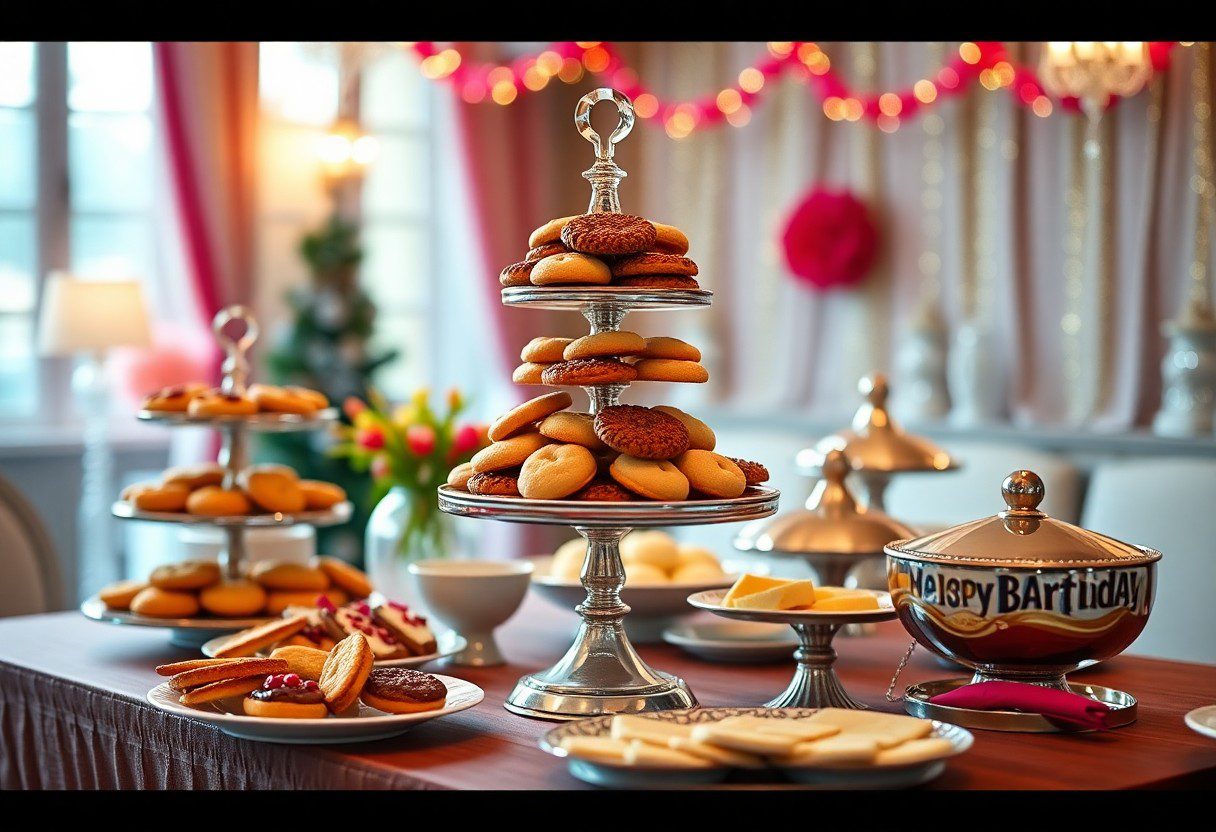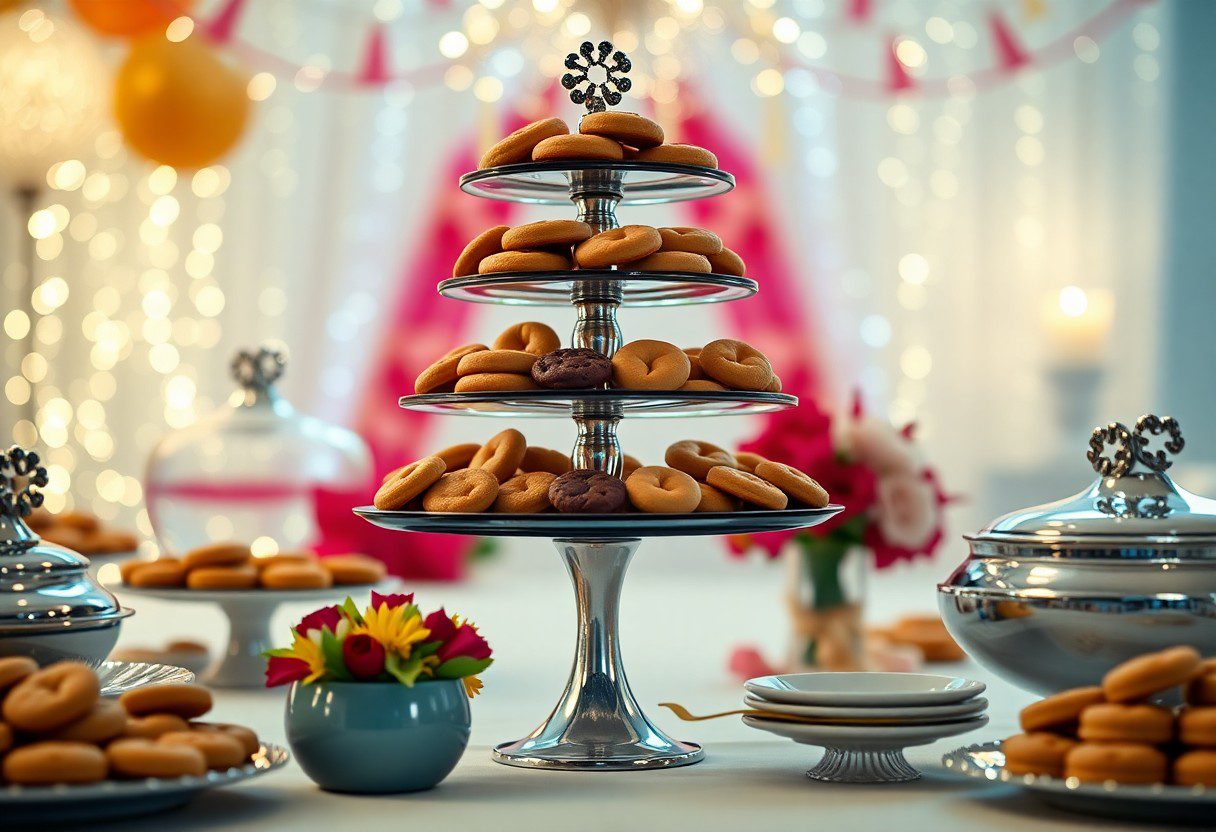Over the years, you may have discovered that the presentation of your delicious cookies can elevate them from a simple dessert to a stunning centerpiece at any party. With the right techniques, you can showcase your cookies in a way that dazzles your guests and enhances the overall theme of your event. In this guide, you will learn several creative and eye-catching ways to display your cookies, ensuring they steal the spotlight and leave a lasting impression on everyone at your gathering.
Crafting the Perfect Cookie Selection
To impress your guests, curate a selection of cookies that not only looks beautiful but also caters to diverse tastes. Aim for a mix of textures—chewy, crunchy, and soft—along with a variety of shapes and sizes. Consider featuring classic favorites like chocolate chip and snickerdoodle, while introducing unique options like lavender lemon or chai spice to pique curiosity. A well-thought-out assortment ensures that there’s something for everyone, creating a delightful experience that sparks conversation and enjoyment.
Choosing Flavor Profiles: Balancing Sweet and Savory
Creating a harmonious blend of sweet and savory flavors elevates your cookie offerings to new heights. Incorporate ingredients like sea salt or pretzels into your sweet treats, which enhances flavors and adds an unexpected twist. For example, a chocolate chip cookie with a sprinkle of sea salt provides a mouthwatering contrast that keeps tastebuds intrigued. Adding savory elements like herbs or cheese can also introduce an exciting dimension, appealing to those who appreciate sophisticated flavor profiles.
Considering Dietary Restrictions: Inclusivity in Treats
Accommodating various dietary needs reflects your attention to guest experience. Offering gluten-free or vegan options not only ensures everyone can enjoy the treats but also shows respect for individual health choices. A gluten-free oatmeal raisin cookie or a dairy-free peanut butter cookie can easily delight all palates without sacrificing flavor. Thinking ahead about these options demonstrates your commitment to making the party enjoyable for everyone.
By proactively addressing dietary restrictions, you make your gathering more inclusive and thoughtful. Options like nut-free, vegan, and gluten-free cookies should be clearly labeled to help guests navigate their choices easily. You can also consider offering cookies made from alternative flours, such as almond or coconut, which can appeal to those seeking healthier alternatives. Engaging with your guests in advance about their preferences will allow you to optimize your menu so that no one feels left out. This way, you create a welcoming environment where every guest can indulge in the sweetest moments of your party.
Artistic Arrangements: Elevating Presentation
Intricately designed displays can transform your cookie table into the centerpiece of the party. By focusing on artistic arrangements, you have the chance to not only please the palate but also to enchant the eyes. Think of how the layout, colors, and textures can reflect your event’s theme. Combine various serving dishes like tiered stands, clear jars, and ornate platters to create visual interest, ensuring each cookie tells its own story while contributing to a cohesive design that captivates your guests.
Utilizing Color Theory: Complementary Palettes
Employing complementary color palettes enhances your cookie presentation, making it more appealing and dynamic. For example, pairing vibrant red velvet cookies with cool green mint or incorporating pastel-colored sugar cookies can create a stunning visual contrast that draws in onlookers. By using colors that complement each other, you not only elevate your display but also evoke emotions and set the tone for your gathering. This approach encourages your guests to indulge in the treats while celebrating the aesthetics of their surroundings.
Embracing Height and Dimension: Stacking Techniques
Height and dimension bring a playful element to your cookie presentation. Utilize various platters, cookie jars, and stands to stack your cookies, creating visually striking layers. For example, placing shorter cookies at the front while gradually increasing the height toward the back allows for a layered effect, drawing the eye to different sections. Using cake stands or pedestals can effectively create that height, showcasing beautifully decorated cookies or unique shapes on different levels, making it easier for guests to reach for their favorites.
Incorporating elements of stacking can be achieved through a few simple techniques. Layer different types of cookies, such as oversized decorated cookies on the top of a tiered stand, while placing smaller treats like mini chocolate chip cookies below. Mix different shapes, sizes, and even textures to create a stunning visual narrative. For instance, adding colorful embellishments, such as edible glitter or sprinkles, enhances the three-dimensional look as cookies glisten under the light. This artistic play encourages guests to explore your spread and increases the likelihood of them trying multiple cookie varieties, enhancing their overall experience.
Displaying with Purpose: Creating Thematic Stations
Building thematic stations around your cookie display not only adds visual excitement but also creates an engaging experience for your guests. Consider themes that resonate with your event, such as a winter wonderland with frosted sugar cookies or a tropical fiesta with vibrant decorated cookies. Each station can feature a unique selection of cookies, accompanied by themed decorations, which encourages interaction and enhances the overall atmosphere. Integrating elements that reflect the season or occasion ties everything together, making your display not just a treat but a memorable part of the celebration.
Designing a Cookie Bar: Interactive Elements
To elevate your cookie display, think about including interactive elements that invite guests to personalize their experience. A DIY cookie decorating station can be a big hit, where you provide various icing colors, sprinkles, and edible decorations. Alternatively, you might set up a “build your own cookie sandwich” area with different cookie types and fillings, allowing guests to create their perfect combination. These interactive features not only make your cookie bar more dynamic but also encourage mingling and conversation among guests.
Pairing Cookies with Accents: Drinks and Decorative Items
Enhancing your cookie display with complementary drinks and decorations creates a cohesive and inviting experience. Consider pairing cookies with themed beverages like milk, coffee, or festive cocktails that complement the flavors of your cookies. You can also incorporate decorative items such as colorful plates, thematic napkins, or seasonal centerpieces that harmonize with both your cookie selection and overall event theme, producing a visually appealing buffet.
Beverages can significantly accentuate the cookie flavors and enhance the overall experience for your guests. For instance, spice cookies pair beautifully with chai tea, while citrus cookies go wonderfully with a refreshing lemonade. Enhance the aesthetic by using decorative drink dispensers with labels that coordinate with your theme. Incorporate decorative touches like mini cookie platters or beautiful cake stands to draw attention to your cookie varieties and make the entire display feel intentional and thoughtfully designed.
Maximizing Freshness and Appeal
The key to a successful cookie display lies in maintaining their freshness and visual allure. Opt for airtight containers or decorative jars to keep cookies soft and flavorful, as exposure to air can lead to dryness. Placing a slice of bread in the container with your cookies can help maintain moisture, ensuring each bite is as delightful as the first. Additionally, consider varying the types of cookies; a mix of textures and flavors not only entices the eye but also caters to diverse palates, making your display more appealing to all guests.
Storage Solutions: Keeping Cookies Delicious
Store cookies at room temperature in sealed containers to ensure they remain soft and moist. If you’re preparing them in advance, freeze baked cookies layered between parchment paper and placed in a freezer-safe container for up to three months. To serve, thaw them overnight in the refrigerator and bring them to room temperature before displaying. This method not only preserves their freshness but also allows you to bake ahead of time, reducing pre-party stress while ensuring your cookies taste just as good as freshly baked.
Preparing for the Party: Ideal Timing for Display
Timing your cookie display perfectly can elevate the party atmosphere significantly. Aim to set up your cookie station no more than one hour before guests arrive. This window allows you to present the cookies while they still appear fresh and appetizing, avoiding drying out or losing allure. If you’re using more perishable items like icing or fillings, ensure these are added right before the display to maintain their visual appeal and taste.
Setting up your cookie display just before guests arrive not only keeps your treats looking fresh but also allows you to capture the excitement in the room. Guests often flock to sweet stations as the party kicks off, so being prepared helps create an inviting atmosphere right away. Use this last hour to arrange cookies charmingly, add finishing touches, and even create a fun ambiance with lighting or decorative elements, further enhancing the visual appeal of your cookie station before the celebration begins.
Enhancing the Experience: Engaging Guests
Creating an immersive cookie experience elevates your party from a simple gathering to a delightful event. Engaging your guests not only enhances their enjoyment but also fosters a sense of connection among them. Incorporate interactive elements that spark conversation and add an element of fun to your cookie display. From flavor inspirations to taste tests, each interaction can add a memorable touch that will leave a lasting impression on your guests.
Creative Flavor Cards: Informative Touchpoints
Flavor cards serve as informative touchpoints that guide your guests through the cookie selection. Handwritten or elegantly printed cards can describe each cookie’s ingredients, flavors, or unique twists. Adding pairing suggestions—like beverages or other treats—can also enhance their tasting experience. Including fun facts, such as the origin of a specific flavor or historical tidbits about the cookie itself, adds an engaging layer that invites conversation and exploration.
Cookie Tasting: Guiding Palates
Host a cookie tasting to guide your guests’ palates and enhance their sensory experience. Arrange an assortment of cookies, encouraging attendees to sample and compare flavors side by side. Provide small plates for individual tastings, along with note cards where they can jot down their thoughts or favorites. This interactive approach not only makes your display more engaging but also allows guests to discover new flavor profiles and perhaps vote for the ultimate fan favorite. To further its appeal, consider organizing tasting flights based on common themes—like decadent chocolate, fruity or nutty cookies—inviting guests to explore and discuss each one.
Final Words
From above, you can see that displaying cookies at a party involves a balance of creativity and practicality. Choose attractive platters or tiered stands to highlight the variety of cookies you’ve prepared. Incorporate decorative elements like fresh greenery or themed decorations to elevate the presentation. Ensure you have enough space for guests to easily access and serve themselves without causing a mess. By considering these tips, you can create an inviting and appealing cookie display that will enhance your party atmosphere and delight your guests.
FAQ
Q: What are some creative ways to display cookies at a party?
A: There are many fun and creative ways to display cookies at a party. You can use tiered cake stands to create height and visual interest, or arrange cookies on decorative platters or trays. For a themed party, consider using cookie jars or containers that match the theme. You can also create a “cookie bar” where guests can choose their favorites from a selection displayed in jars or bowls.
Q: How can I make my cookie display look appealing?
A: To enhance the aesthetic of your cookie display, use various colors and shapes of cookies to create contrast and interest. Incorporate decorative elements such as fresh flowers, ribbons, or themed decorations that complement the party’s theme. Utilize different heights by stacking cookies or using stands, and ensure that the display area is well-lit to highlight the cookies.
Q: What types of cookies are best for a party display?
A: Variety is key for a party cookie display. Include a mix of classic favorites like chocolate chip, sugar cookies, and oatmeal raisin, along with some more unique options such as macarons, whoopie pies, or decorated sugar cookies. Offering gluten-free or vegan options can also cater to different dietary preferences, ensuring all guests can enjoy the treats.
Q: How far in advance can I bake cookies for a party display?
A: Cookies can generally be baked a few days in advance and stored properly to maintain freshness. Most cookies can be made 1-2 days before the event if stored in an airtight container. For larger parties, it’s advisable to freeze cookies a week or two in advance, then thaw them the day before the party to ensure they taste freshly baked.
Q: How can I keep cookies fresh throughout the party?
A: To keep cookies fresh during the event, consider covering them with a dome lid or using a glass cloche. If the party is outdoors, placing the cookies in shade can help prevent them from melting or becoming too soft due to heat. It’s also helpful to monitor the display and replenish cookies as needed, ensuring that they remain appealing and delicious for your guests.





